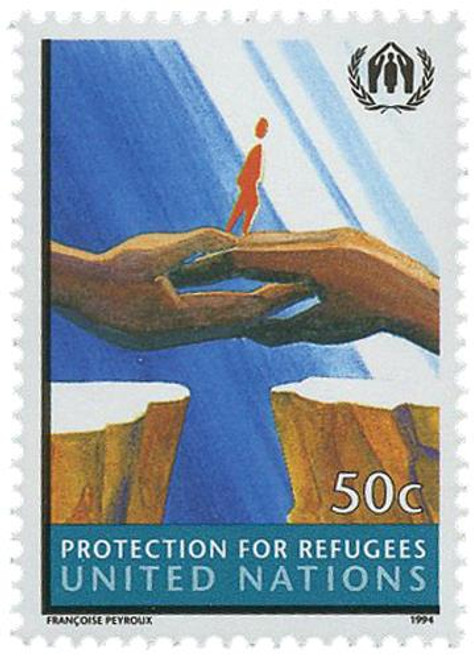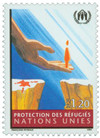
1994 Protection for Refugees
# UNG250 - 1994 Protection for Refugees
$3.25
1994 Protection for Refugees
UN Offices in Geneva
UN Offices in Geneva
Three 1994 stamps honor the work of the Office of the United Nations High Commissioner for Refugees (UNHCR). The designs, created by Françoise Peyroux of France, illustrate the three solutions available to refugees under the auspices of the UNHCR: voluntary return to their country of origin, integration into the country of asylum, or resettlement in a third country.
Since 1951, the UNHCR has aided refugees with immediate humanitarian assistance and with intergovernmental negotiations for long-term solutions. Historically, refugees were victims of international conflicts, forced to flee before the enemy or from their own government which found their social, political, or religious beliefs reasons to deprive them of life and liberty. Today’s refugees are generally victims of national conflicts. 19 million have crossed borders seeking asylum while 25 million are “internally displaced” in their own countries.
The High Commissioner and the United Nations believe the best solution to the problems of refugees lies in the acceptance and exercise of human rights by all the nations of the world. When fundamental human rights are respected, people are not driven to become refugees.
1994 Protection for Refugees
UN Offices in Geneva
UN Offices in Geneva
Three 1994 stamps honor the work of the Office of the United Nations High Commissioner for Refugees (UNHCR). The designs, created by Françoise Peyroux of France, illustrate the three solutions available to refugees under the auspices of the UNHCR: voluntary return to their country of origin, integration into the country of asylum, or resettlement in a third country.
Since 1951, the UNHCR has aided refugees with immediate humanitarian assistance and with intergovernmental negotiations for long-term solutions. Historically, refugees were victims of international conflicts, forced to flee before the enemy or from their own government which found their social, political, or religious beliefs reasons to deprive them of life and liberty. Today’s refugees are generally victims of national conflicts. 19 million have crossed borders seeking asylum while 25 million are “internally displaced” in their own countries.
The High Commissioner and the United Nations believe the best solution to the problems of refugees lies in the acceptance and exercise of human rights by all the nations of the world. When fundamental human rights are respected, people are not driven to become refugees.











